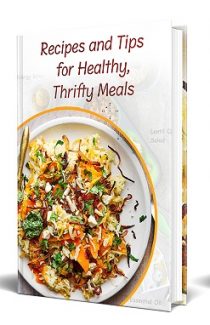
 License Type: Private Label Rights
License Type: Private Label Rights  File Type: ZIP
File Type: ZIP
 SKU: 65302
SKU: 65302  Shipping: Online Download
Shipping: Online Download
Sample Content Preview
INTRODUCTION
How can you serve healthy meals on a limited budget? It takes some time and planning, but you and your family can eat better for less. This booklet can help you save money as you prepare healthy meals. It contains
• Tips for planning, shopping, and cooking healthy meals on a tight budget
• Sample menus for 2 weeks for breakfast, lunch, dinner, and snacks
• Recipes for healthy, thrifty meals
• Lists of the foods needed for each weekly menu
TIPS FOR HEALTHY, THRIFTY MEALS
WHY PLAN MEALS?
To help you and your family be healthier. When you plan meals, you can make sure you include enough foods from each food group. Pay special attention to serving enough vegetables and fruits in family meals.
To help you balance meals. When you are serving a food with a lot of fat or salt, you can plan lowfat or low-salt foods to go with it. For example, ham is high in salt. If you have ham for dinner, you also can serve a salad or a vegetable that doesn’t need salt.
To save money. If you plan before you go food shopping, you will know what you have on hand and what you need. Also, shopping from a list helps you avoid expensive “impulse” purchases.
To save time and effort. When you plan meals, you have foods on hand and make fewer trips to the grocery store. Planning also helps you make good use of leftovers. This can cut your cooking time and food costs.
TIPS FOR PLANNING
Build the main part of your meal around rice, noodles, or other grains. Use small amounts of meat, poultry, fish, or eggs.
• For example, make a casserole by mixing rice, vegetables, and chicken. Or try Beef-Noodle Casserole (p. 22) or Stir-Fried Pork and Vegetables with Rice (p. 26).
Add variety to family meals. In addition to cooking family favorites, try new, low-cost recipes or food combinations.
• For example, if you usually serve mashed potatoes, try Baked Crispy Potatoes (p. 49) or Potato Salad (p. 58) for a change.
Make meals easier to prepare by trying new ways to cook foods.
• For example, try using a slow cooker or crock-pot to cook stews or soups. They cook foods without constant watching.
Use planned leftovers to save both time and money.
• For example, prepare a Beef Pot Roast (p. 21), serve half of it, and freeze the remaining half to use later. You also can freeze extra cooked meats and vegetables for soups or stews.
Do “batch cooking” when your food budget and time allow.
• For example, cook a large batch of Baked Meatballs (p. 20) or Turkey Chili (p. 39), divide it into family-size portions, and freeze some for meals later in the month.
Plan snacks that give your family the nutrients they need.
• For example, buy fresh fruits in season like apples or peaches. Dried fruits like raisins or prunes, raw vegetables, crackers, and whole wheat bread are also good ideas for snacks.
TIPS FOR SHOPPING
Before you go shopping
• Make a list of all the foods you need. Do this in your kitchen so you can check what you have on hand.
• Look for specials in the newspaper ads for the stores where you shop.
• Look for coupons for foods you plan to buy. But remember, coupons save money only if you need the product. Also, check if other brands are on sale, too. They may cost even less than the one with a coupon.
- License: Private Label Rights
- Category:Ebooks
- Tags:2023 Ebooks Private Label Rights







